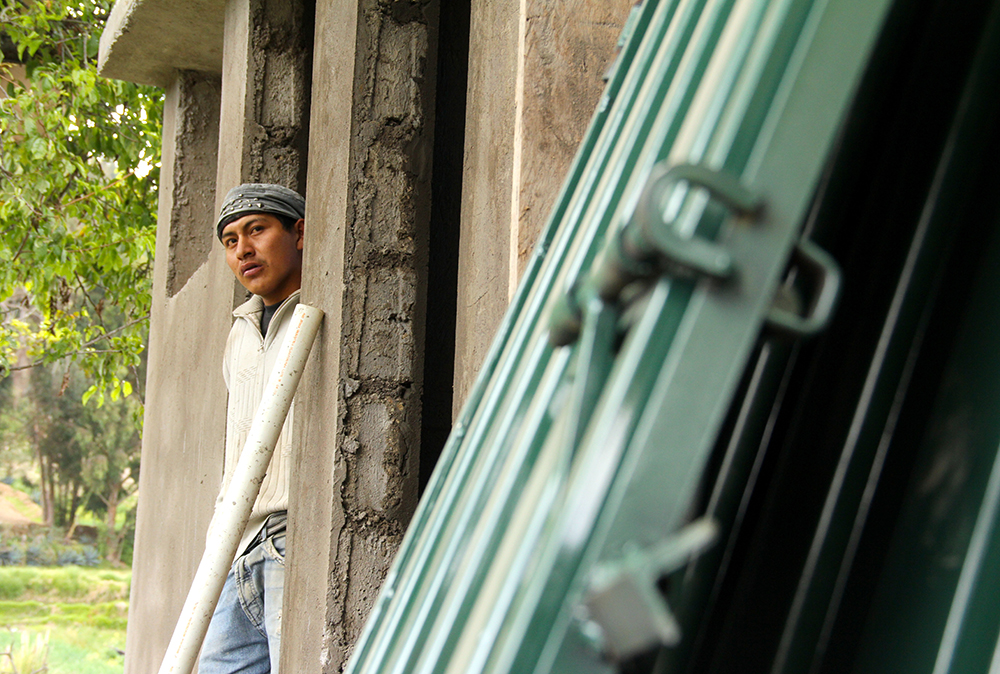Don Pedro picks us up in the late morning.
Martha sits in the front seat, and I sandwich myself between Mirian Manzano, a coordinator for Colta’s Department of Education, and her friend from the municipal government. The bed of Don Pedro’s white pick up truck is weighted down with six metal doors. We are delivering them to two Colta schools, Colluctus and Mariano Borja, for their bathroom construction sites.
Don Pedro often drives us to the communities we work in; he is an elderly indigenous man with a short stature and wrinkled forehead. Like most Ecuadorian taxi drivers, he enjoys illegally cutting across the double yellow lines of the road to pass slower cars we happen to fall behind. Two Christmas-tree-shaped deodorizers hang from his mirror. One has a snowflake pattern, mocking us in the unusually hot weather today.
He drives on back roads of dust and rock, paralleling the train tracks, to avoid traffic. The women in the backseat grumble, and shut their windows. Mirian asks me where the “furry thing” for my camera microphone is today. She laughs when I take it out, and delights in the name. It’s called a “dead cat” and it’s for reducing wind noises.
Upon arriving to Mariano Borja, there was but one parent volunteer, a young construction worker named Oswaldo Vala. One of the school teachers forgot to coordinate parent volunteers the day before, and with work to do in the fields, the typical group of at least four were not able to come. With only 14 teachers for about 250 students at Mariano Borja, it’s been difficult for them to divert their attention to the bathroom project.
After delivering three doors to the site, we learn there have been other setbacks for the project.
Originally, Mariano Borja was scheduled for completion by November 26th. But the volunteers underestimated the time is takes for the cement to dry over the wooden beams on the roof. It typically takes ten days, so they are now a week over schedule. Without being thoroughly dried, the roof could collapse.
But there’s been significant progress. Today, the bathroom walls have a thick layer of cement covering them, smoothing the previously naked cinderblock skeleton. It’s ready to be painted the classic MEDLIFE colors — yellow and orange — come Monday, along with the installation of the toilets. The doors are to be positioned on Wednesday, December 12th, for it’s final opening to the student body.
And it can’t be soon enough. A foul smell emanates from the previous bathrooms. I see three young girls skitter out of the stalls, desperate to escape the fumes. The floor is coated in a muddy veil of footsteps from use. It’s only noon.
After leaning Mariano Borja’s three doors against the soon-to-be bathroom, we head off to another Colta school, Culluctus.
Culluctus sits high up in the hills of the Chimborazo region at 3,585 meters. There are two school houses about a 5 minute walk from one another for nearly 200 students, ages three until 17 years of age. The newer school house, with four classrooms and two stories, previously had no bathroom at all. Each classroom houses about 26 students.
When we arrive to the bathroom site, the school grounds are deserted. The school’s sub-director’s mother-in-law has passed away. In indigenous tradition, the entire student body is at the cemetery paying their respects and showing support.
Two volunteers dot the hilly landscape. Maria Rosa Paguay Ortiz, a mother of a 10-year-old student at the school, and Rodrigo Yepez, older brother of two students at the school ages 9 and 10, are digging a large hole where the septic tank will be buried. The doorless bathroom structure itself is completed, awaiting the arrival of toilets.
Maria gestures to the bumpy field in front of the school house, where chickens squawk and roam. She tells us that previously, her son would have to scout for a bush or tree behind which to relieve himself, interrupting classes and without any way to clean himself.
“Bathrooms are the first necessity for a school. How can they [students] do their school work without them?” she says. Rodrigo nods in agreement. When I ask them to write down their full names in my notebook, Maria carefully prints hers in petite, floral lettering. Rodrigo gives an embarrassed shrug. He was never able to learn how to write.
The bathrooms at Culluctus are slated for completion by the end of the second week of December.
Rachel Hoffman is a MEDLIFE media intern based out of Riobamba, Ecuador

